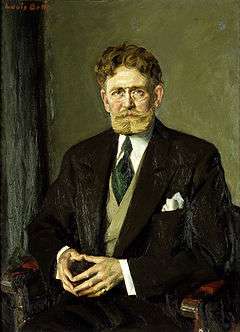J. Hamilton Lewis
| J. Hamilton Lewis | |
|---|---|
 | |
| 1st and 5th Senate Majority Whip | |
|
In office March 4, 1933 – April 9, 1939 | |
| Preceded by | Simeon D. Fess |
| Succeeded by | Sherman Minton |
|
In office March 4, 1913 – March 3, 1919 | |
| Preceded by | office created |
| Succeeded by | Charles Curtis |
| United States Senator from Illinois | |
|
In office March 26, 1913 – March 3, 1919 | |
| Preceded by | Shelby Moore Cullom |
| Succeeded by | Joseph M. McCormick |
|
In office March 4, 1931 – April 9, 1939 | |
| Preceded by | Charles S. Deneen |
| Succeeded by | James M. Slattery |
| Member of the U.S. House of Representatives from Washington's at-large district | |
|
In office March 4, 1897 – March 3, 1899 | |
| Preceded by | William H. Doolittle |
| Succeeded by | Francis W. Cushman |
| Personal details | |
| Born |
James Hamilton Lewis May 18, 1863 Danville, Virginia |
| Died |
April 9, 1939 (aged 75) Washington, D.C. |
| Political party | Democratic |
| Alma mater | University of Virginia |
| Profession | Lawyer |
James Hamilton Lewis (May 18, 1863 – April 9, 1939) was the first Senator to hold the title of Whip in the United States Senate. Lewis was born in Danville, Virginia, and also grew up in Augusta, Georgia. He was educated at the University of Virginia and studied law in Savannah, Georgia before he served in the Spanish–American War.
Congressional career
Lewis was one of a very few politicians to represent two states in the United States Congress. Lewis represented Washington (1897–1899) in the United States House of Representatives as a Democrat, and went on to serve Illinois (1913–1919, 1931–1939) in the United States Senate as a member of the Democratic Party. Lewis served as Majority Whip from 1913 until 1919. At some point in his congressional career, he became known to colleagues as "Ham".
A close ally of President Woodrow Wilson, Lewis was a leader in getting much of Wilson's "New Freedom" legislation passed. Upon his defeat for reelection in '18, Lewis was offered the ambassadorship to Belgium by the President, but he declined and returned private legal practice in Chicago, Illinois. He eventually became a partner in the newly named Lewis, Adler, Lederer & Kahn (now known as Arnstein & Lehr, LLP) where he remained until he began his campaign for return to the United States Senate.[1]
He would hold the Majority Whip position again from 1933 until his death in 1939. He was defeated for reelection to the Senate in 1918, but regained his seat in the election in 1930. He ran unsuccessfully for governor of Illinois in 1908 and 1920, and continued to serve as Minority Whip in the Senate during the Depression and the New Deal era. Lewis won his last Senate election in 1936, and died in office in 1939.
In 1932, Lewis went to the Democratic National Convention in Chicago, as the "favorite son" candidate of Illinois, at the behest of Chicago mayor Anton Cermak. Cermak's hope was to use Lewis to keep the Illinois delegates from supporting Franklin Delano Roosevelt, but Lewis later withdrew his name from consideration, and released his delegates, many of whom went to FDR and helped secure him the nomination.
Lewis was one of the first to befriend the new, and rather intimidated, Senator Harry S Truman. In 1935, during Truman's first few weeks in office, Lewis sat next to Truman and kindly said "Harry, don't start out with an inferiority complex. For the first six months you'll wonder how the hell you got here. After that you'll wonder how the hell rest of us got here."[3]
Lewis was known to be something of an eccentric in manner and dress, wearing spats well into the 1930s, and sporting Van Dyke whiskers and a "wavy pink toupee", but he was courtly in manner, and a talented orator. He was an authority on the U.S. Constitution and on foreign affairs, and a skillful legislative tactician. He died in office, and his funeral service was held in the Senate Chamber.
Lewis was buried in Abbey Mausoleum near Arlington National Cemetery. But it was demolished in 2001, and his remains were moved to an unknown location.
References
| Wikisource has original works written by or about: James Hamilton Lewis |
- United States Congress. "James Hamilton Lewis (id: L000284)". Biographical Directory of the United States Congress.
- Notes
- ↑ Chicago Tribune, November 11, 1923
- ↑ Taylor, Julius F. "The Broad Ax". Illinois Digital Newspaper Collections. Retrieved 18 June 2015.
- ↑ McCullough, David: Truman. Simon and Schuster, New York, New York. 1992. P. 214
External links
- Works by J. Hamilton Lewis at Project Gutenberg
- Works by or about J. Hamilton Lewis at Internet Archive
- portrait of James Hamilton Lewis
| United States House of Representatives | ||
|---|---|---|
| Preceded by William H. Doolittle |
Member of the U.S. House of Representatives from Washington's 2nd congressional district 1897–1899 |
Succeeded by Francis W. Cushman |
| United States Senate | ||
| Preceded by Shelby M. Cullom |
Class 2 U.S. Senator from Illinois 1913–1919 |
Succeeded by Medill McCormick |
| Preceded by Charles S. Deneen |
Class 2 U.S. Senator from Illinois 1931–1939 |
Succeeded by James M. Slattery |
| Party political offices | ||
| Preceded by (none) |
United States Senate Majority Whip 1913–1919 |
Succeeded by Charles Curtis |
| Preceded by Simeon D. Fess |
United States Senate Majority Whip 1933–1939 |
Succeeded by Lister Hill |
